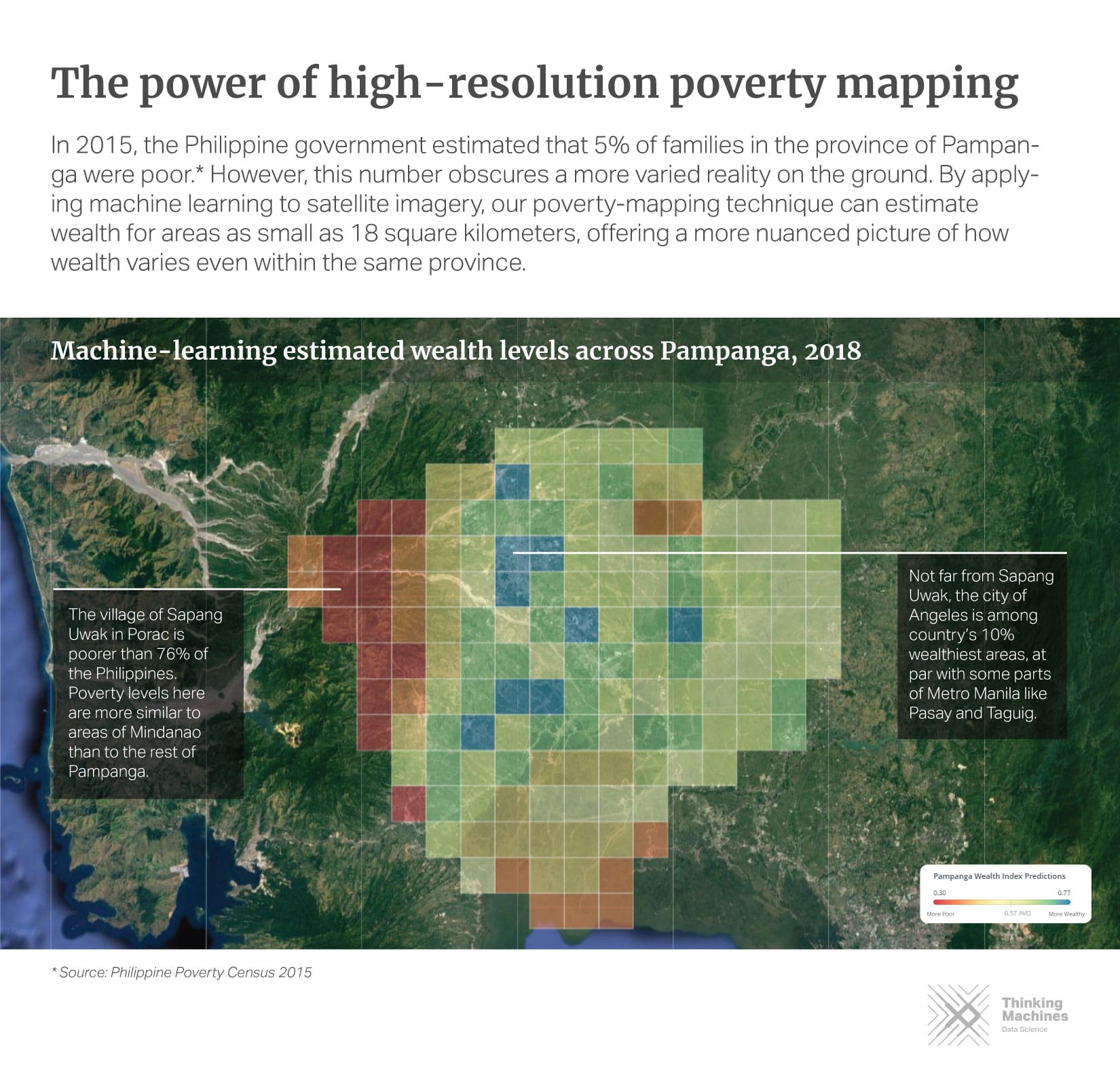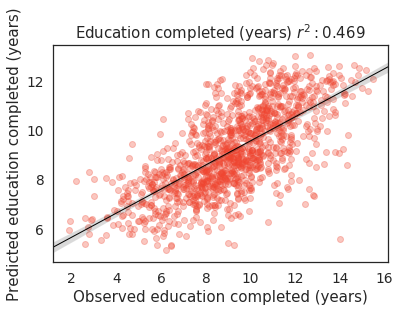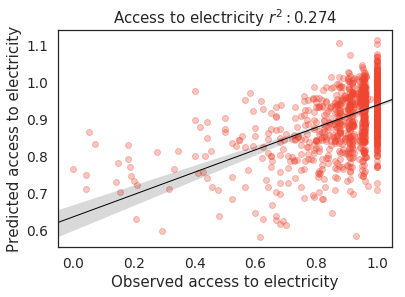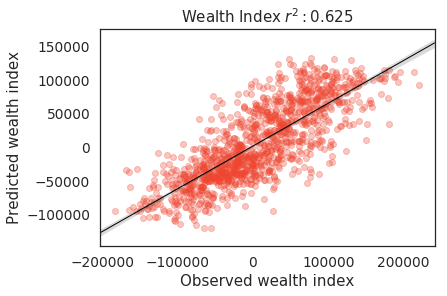Setup | Code Organization | Data Sources | Models | Key Results | Acknowledgements
This repository accompanies our research work, "Mapping Philippine Poverty using Machine Learning, Satellite Imagery, and Crowd-sourced Geospatial Information", currently published in our website. In this work, we developed five wealth prediction models using state-of-the-art methods and various geospatial data sources.
In order to run the notebooks, all dependencies must be installed. We provided
a Makefile to accomplish this task:
make venv
make buildThis creates a virtual environment, venv, and installs all dependencies found
in requirements.txt. In order to run the notebooks inside venv, execute the
following command:
ipython kernel install --user --name=venvNotable dependencies include:
- matplotlib==3.0.2
- seaborn==0.9.0
- numpy==1.16.0
- pandas==0.24.0
- torchsummary==1.5.1
- torchvision==0.2.1
- tqdm==4.30.0
This repository is divided into three main parts:
- notebooks/: contains all Jupyter notebooks for different wealth prediction models.
- utils/: contains utility methods for loading datasets, building model, and performing training routines.
- src/: contains the transfer learning training script.
It is possible to follow our experiments and reproduce the models we've built by going through the notebooks one-by-one. For model training, we leveraged a Google Compute Engine (GCE) instance with 16 vCPUs and 60 GB of memory (n1-standard-16) and an NVIDIA Tesla P100 GPU.
- Demographic and Health Survey (DHS): we used the 2017 Philippine Demographic and Health Survey as our measure of ground-truth for socioeconomic indicators. It is conducted every 3 to 5 years, and contains nationally representative information on different indicators across the country.
- Nighttime Luminosity Data: we obtained nighttime lights data from the Visible Infrared Imaging Radiometer Suite Day/Night Band (VIIRS DNB) for the year 2016. It includes a continuous luminosity level from 0 to 122, where 0 is the darkest pixel.
- Daytime Satellite Imagery: we captured 134,540 satellite images from the Google Static Maps API. Our parameter settings are as follows: zoom level=17, scale=1, and image size=400x400pixels. These images match the land area covered by a single pixel of night time lights data (0.25-sq.km).
- High Resolution Settlement Data (HRSL): we used this dataset, provided by Facebook Research, CIESIN Columbia, and World Bank, to filter out images without human settlements. Their population estimates were based on recent census data and high resolution satellite imagery (0.5-m) from DigitalGlobe.
- OpenStreetMaps Data (OSM): we acquired crowd-sourced geospatial data from OpenStreetMaps (OSM) via the Geofabrik online repository. This dataset is volunteer-curated, and covers almost 83% of the entire Philippine street network.
We developed five wealth prediction models from different data sources. You can
follow-through our analysis by looking at the notebooks in the notebooks/
directory.
- Survey Model (
notebooks/01_survey_model.ipynb): we extracted features such as urban/rural classification, proportion of households with a car/truck, avg. number of rooms used for sleeping, and etc. This model serves as our baseline or "gold standard" against which other remote-sensing based techniques will be compared. - Nighttime Lights Transfer Learning Model (
notebooks/04_transfer_model.ipynb): we used a transfer learning approach proposed by Xie et al and Jean et al. The main assumption here is that nighttime lights act as a good proxy for economic activity. We first started with a Convolutional Neural Network (CNN) pre-trained on ImageNet, and used the feature vectors into a ridge regression model. - Nighttime Lights Statistics Model (
notebooks/02_lights_eda.ipynb,notebooks/03_lights_model.ipynb): in this model, we generated nighttime light features consisting of summary statistics and histogram-based features. We then compared the performance of three different machine learning algorithms: ridge regression, random forest regressor, and gradient boosting method (XGBoost). - OpenStreetMaps (OSM) Model (
notebooks/05_osm_model.ipynb): we extracted three types of OSM features, roads, buildings, and points-of-interests (POIs) within a 5-km radius for rural areas and 2-km radius for urban areas. We then trained a random forest regressor for these features. - OpenStreetMaps (OSM) + Nighttime Lights (NTL)
(
notebooks/02_lights_eda.ipynb,notebooks/05_osm_model.ipynb): we also trained a random forest model combining OSM data and nighttime lights-derived features as input. This is motivated by the assumption that using features from mixed data sources will improve model performance.
To view the full results, please see our technical notes here. We found out that for the four models (excluding the survey model), OSM-based features, especially OSM + Nighttime Lights, serve as a good previctor for socioeconomic well-being:
Cross-validated r-squared results for predicting cluster-level poverty measures across all levels
| Survey | Lights | Transfer* | OSM | OSM+Lights | |
|---|---|---|---|---|---|
| Wealth Index | 0.773 | 0.568 | 0.625 | 0.588 | 0.620 |
| Education | 0.605 | 0.435 | 0.469 | 0.464 | 0.485 |
| Access to Electricity | 0.368 | 0.292 | 0.274 | 0.320 | 0.345 |
| Access to Water | 0.030 | 0.058 | 0.097 | 0.049 | 0.056 |
*includes regional indicators.
Predictions on different socioeconomic indicators using the OSM + Lights model
This work was supported by the UNICEF Innovation Fund. We would also like to thank Vedran Sekara, Do-Hyung Kim of UNICEF and Priscilla Moraes of Google for the insightful discussions and valuable mentorship.




